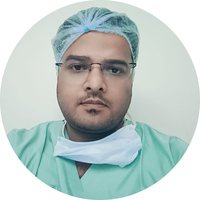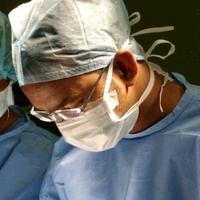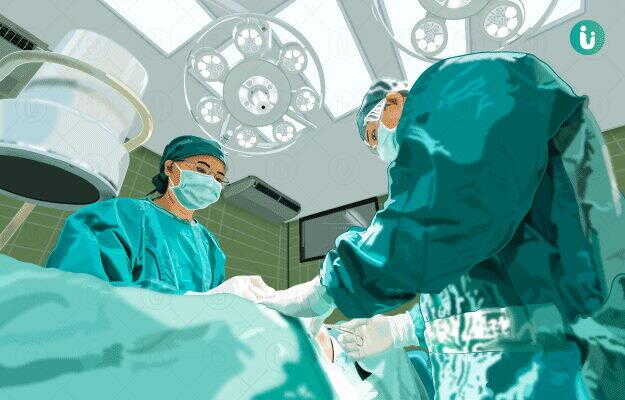Pilonidal cyst surgery is a minor surgical procedure to remove a pilonidal cyst. Despite excision of the cyst, recurrence is common.
A pilonidal cyst is a sac that forms around a hair follicle. It is typically located between the cheeks of the buttocks near the tailbone of the person. It is commonly seen in hairy young males as compared to females.
The cyst can progress to infection and may later develop a sinus that discharges pus, hence the condition is required to be treated on priority.
The procedure is a minor one and the patient is usually admitted in the morning and discharged by the evening.
Aftercare of the wound is crucial since the wound is prone to get infected if proper care is not taken. The wound can take 3 weeks to 3 months to heal depending on the procedure performed.
- What is pilonidal cyst surgery
- Indications for the surgery
- Contraindications for the surgery
- Preparations before surgery
- What happens during the surgery
- Risks and outcome of the surgery
- Aftercare, discharge and follow up
- Takeaway
What is pilonidal cyst surgery
A pilonidal cyst is a sac that forms around a hair follicle and contains hair and debris of the skin. It is located at the end of the tail bone between the cheeks of the buttocks. The cyst may soon progress to develop an abscess (pus-filled swelling) or, further, a sinus (blind tunnel in the skin) that discharges pus and blood.
Pilonidal cyst surgery is the surgical removal of the cyst in its entirety. Primarily there are two procedures:
- Incision and drainage of the cyst: It is done usually if the cyst occurs for the first time and the infection is found to be minor
- Pilonidal cystectomy: This is done if the cyst is recurring (chronic recurrence) or if the infection is found to have progressed to an abscess or discharging sinus.
Indications for the surgery
The reasons for the surgery are associated with the symptoms of the cyst. They include:
- A reddish swelling around the tailbone which is tender. Pain increases more on sitting.
- Abscess formation: The swelling has become infected and contains pus. Associated symptoms are extreme pain, fever and malaise.
- Painless discharging sinus: The abscess has burst and has formed a tract from the cyst to the outside skin discharging pus.
Contraindications for the surgery
There are no actual contraindications for the surgery. However, pre-existing conditions should be under control, for example, diabetes since uncontrolled sugars decrease the rate of wound healing post-surgery and may increase chances of reinfection.
Preparations before surgery
A general surgeon takes a detailed history of the patient. Depending on the severity, the surgeon determines and tells the patient the type of procedure to be performed.
Routine blood investigations are done before the procedure. As such, no special investigation is required.
If the patient is on any medications for pre-existing conditions, the medications may be stopped/altered as per the surgical requirement.
The patient will be advised to arrange for a ride back home after the procedure since the patient will be sore at the place of surgery and may still be under the effect of anaesthesia. The procedure is usually a day-care admission.
What happens during the surgery
There are two approaches to surgical management. They are:
1. Incision and drainage
This method is preferred if the infection is minor and the cyst has occurred for the first time. The patient is shifted to a minor procedure room where they are made to lie prone (flat on their stomach) on the procedure table.
The affected area is cleaned and covered with sterilised drapes. A local anaesthetic is injected to numb the area.
Using a scalpel (a sharp sterile knife) an incision is made in the cyst and the pus is drained. Draining the pus releases the cyst pressure and therefore reduces pain and inflammation.
The wound is cleaned and left open after packing it with medicated gauze. Surrounding hair follicles are removed to ensure better chances of non-recurrence.
Advantages: the procedure is done under local anaesthesia and is relatively quicker than cystectomy.
Disadvantages: the infection may not be eliminated completely from the cyst and hence chances of recurrence are common.
2. Pilonidal cystectomy
This surgery is preferred in more advanced stages where the infection is widespread or a discharging sinus(es) is present. The surgery is performed in the minor operating theatre (OT). The patient is told to fast overnight before the surgery.
Once admitted the patient changes into the hospital gown and is shifted to the OT. The patient is placed in the prone position on the operating table. A monitor is attached to monitor the vitals (heart rate, bp, saturation). An IV cannula is inserted through which general anaesthesia is given. Another option is regional anaesthesia where the lower half of the body is made numb.
The site of surgery is cleaned and covered with sterile drapes. Depending on the extent of infection and the nature of the sinuses (number and depth) the required amount of tissue is removed and the wound is properly cleaned.
If after excision the wound is small, it is then left open and packed with medicated gauze. If the wound is big then it is closed by sutures (stitches). In some cases when there are numerous sinuses, tissue from another location of the body may be used to form a covering (flap) and the wound is sutured. The entire surgery usually takes about 45min to 1 hour.
Advantages: the procedure ensures a better rate of removal of the cyst and sinuses, thereby reducing chances of recurrence
Disadvantages: since the wound is large the time required for healing is prolonged. Complications due to anaesthesia may occur.
Risks and outcome of the surgery
The risks associated with the procedure are minimal. However, the common complications include:
- Recurrence of the cyst: this is the most common complication seen; even after successful surgery chances of recurrence are high
- Fever
- Excessive bleeding or discharge of pus from the wound site
- Increased pain, swelling or redness at the wound site
- In rare cases, chronic infection may lead to a non-healing wound which may progress to skin cancer
Aftercare, discharge and follow up
The patient is kept under observation for a few hours during which the doctor explains about the care of the wound at home. A discharge summary is prepared which contains medications and advice on wound care. These include:
- Continuation of medicines of pre-existing conditions, if any.
- Antibiotics and analgesics to prevent infection and pain respectively.
- Avoid prolonged sitting, especially on hard surfaces. If prolonged sitting is required, the patient should sit on a doughnut-shaped cushion.
- Losing weight is advised in obese individuals since obesity is considered a factor for developing the cyst.
- Regular dressing of the wound should be done to ensure faster healing and prevent infection.
- After bathing, the wound is to be kept dry
- Personal hygiene should be paid attention to. Trimming or shaving of the hair around the buttocks and wearing moisture-absorbent undergarments (cotton) decrease the incidence of infection and by extension future recurrence of the cyst.
- In case of bleeding, pus discharge, extreme tenderness or swelling at the surgical site, the patient should immediately notify the doctor.
The wound healing usually takes between 3 weeks and 3 months for complete healing depending on the procedure performed. Sutures, if any, are removed in the third or fourth week. Follow up is as per the instructions of the doctor.
Takeaway
Pilonidal cyst surgery is a more definitive modality of treatment as compared to non-surgical approaches. The procedure has minimal risk and is of short duration. Cystectomy has a higher success rate as compared to incision and drainage. Aftercare of the wound is important to prevent infection. Despite the procedure having a high success rate, recurrence is known to occur.
Find General surgeon in cities
Surgery Cost In Your City
Doctors for Pilonidal cyst surgery

Dr. Piyush Jain
General Surgery
5 Years of Experience

Dr. Rajive Gupta
General Surgery
28 Years of Experience

Dr. Prity Kumari
General Surgery
















